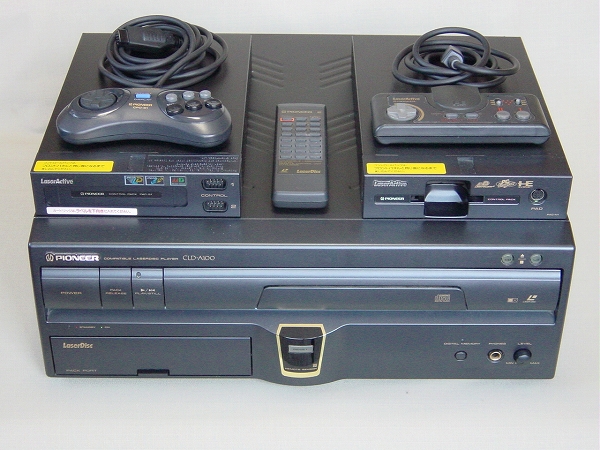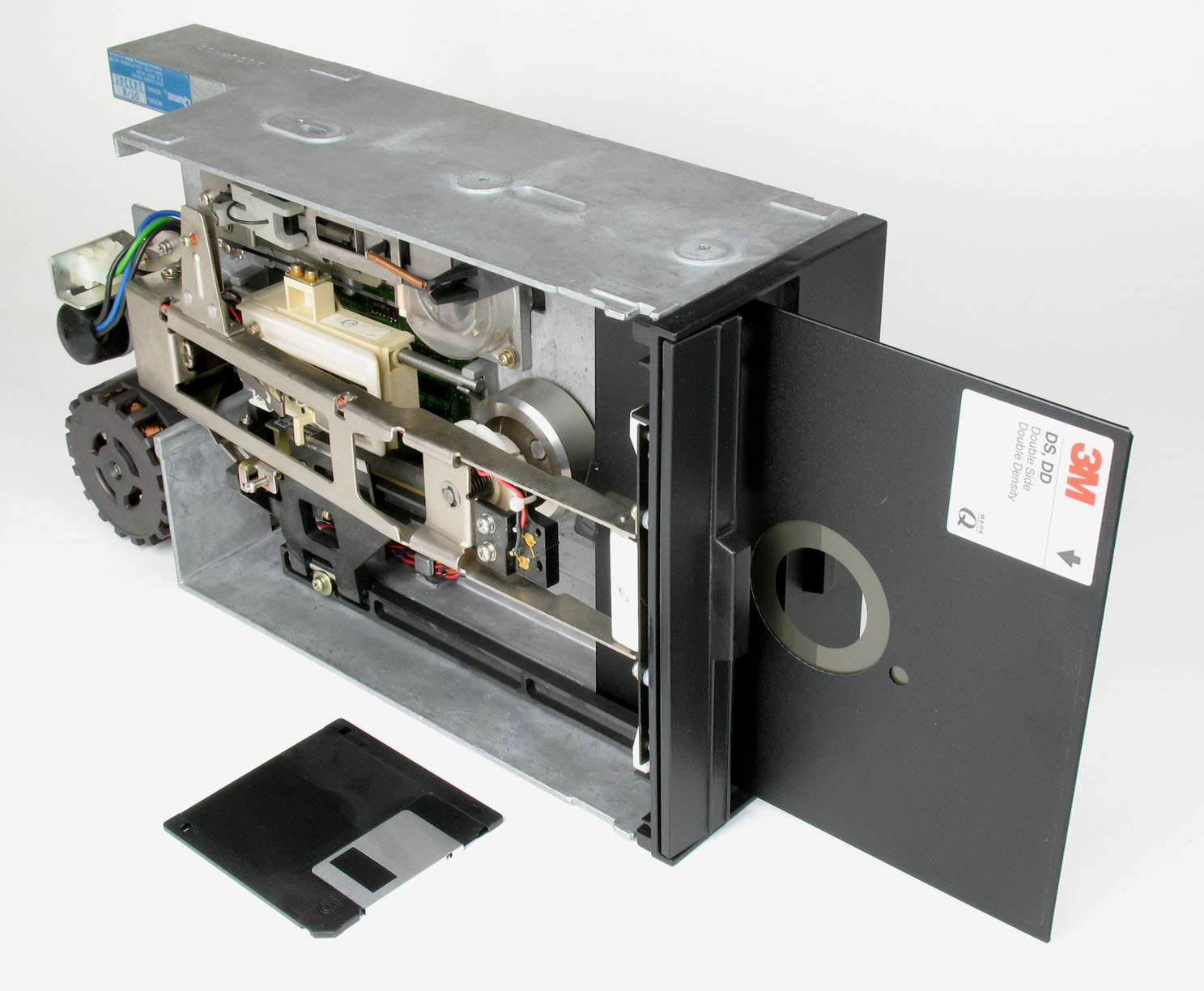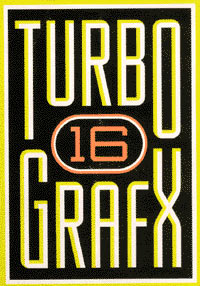|
Pioneer LaserActive
The is a hybrid LaserDisc player and home video game console released by Pioneer Corporation in 1993. Marketed as a high-end, modular entertainment system, it was designed to combine movies, music, and video games into a single unit. Out of the box, the base unit could natively play standard LaserDiscs and Compact discs, but support for video games required optional expansion modules known as PACs. Each PAC enabled compatibility with a specific gaming platform and its media formats. With the Mega-LD PAC, the system could play exclusive Mega-LD discs (a proprietary LD-ROM format), as well as Sega Genesis/Mega Drive cartridges and Sega CD/Mega-CD discs. With the LD-ROM² PAC, it supported exclusive LD-ROM² discs, along with HuCard cartridges and CD-ROM² discs for the PC Engine/TurboGrafx-16. The LaserActive was the only system capable of playing LD-ROM game discs, which were not cross-compatible between PACs. Pioneer released LaserActive model CLD-A100 in Japan on August 2 ... [...More Info...] [...Related Items...] OR: [Wikipedia] [Google] [Baidu] |
Pioneer Corporation
, is a Japanese multinational corporation based in Tokyo, that specializes in digital entertainment products. The company was founded by Nozomu Matsumoto on January 1, 1938 in Tokyo as a radio and Loudspeaker, speaker repair shop. Its current president is Shiro Yahara. Pioneer played a role in the development of interactive cable TV, the Laserdisc, LaserDisc player, the first automotive compact disc, Compact Disc player, the first detachable face car stereo, Supertuner technology, DVD and DVD recording, the first AV receiver with Dolby Digital, plasma display (with the last 2 years of plasma models being branded as Pioneer Kuro, Kuro, lauded for their outstanding black levels) and organic light-emitting diode, Organic LED display (OLED). The company works with optical disc and display technology and software products and is also a manufacturer. BMW, Volkswagen Group and Daimler AG of Germany jointly acquired a 3% ownership stake in Pioneer through a joint venture company called H ... [...More Info...] [...Related Items...] OR: [Wikipedia] [Google] [Baidu] |
HuCard
The (Known as the TurboChip in regions where the PC Engine was marketed as the TurboGrafx-16) is a ROM cartridge in the form of a card, designed by Hudson Soft for NEC's PC Engine and PC Engine SuperGrafx video game consoles, which were originally released in 1987 and 1989, respectively. Development The HuCard is an evolution from an earlier Hudson Soft technology, the Bee Card, which it developed in the early 1980s as a distribution medium for MSX software. The Bee Card is an EEPROM device that is slightly thinner than the HuCard. It has 32 connectors whereas the HuCard has 38. In July 1985, Hudson approached and pitched Nintendo a new add-on for the Famicom that played games using the patented Bee Cards. Nintendo liked this concept, as it had the ability to store full games and overwrite existing ones. However, as the technology for it was expensive, and that they would have to pay royalties for each card sold, Nintendo decided to pass on Hudson's proposal and woul ... [...More Info...] [...Related Items...] OR: [Wikipedia] [Google] [Baidu] |
Active Shutter 3D System
An active shutter 3D system (a.k.a. alternate frame sequencing, alternate image, AI, alternating field, field sequential or eclipse method) is a technique for displaying stereoscopic 3D images. It works by only presenting the image intended for the left eye while blocking the right eye's view, then presenting the right-eye image while blocking the left eye, and repeating this so rapidly that the interruptions do not interfere with the perceived fusion of the two images into a single 3D image. Modern active shutter 3D systems generally use liquid crystal shutter glasses (also called "LC shutter glasses" or "active shutter glasses"). Each eye's glass contains a liquid crystal layer which has the property of becoming opaque when voltage is applied, being otherwise transparent. The glasses are controlled by a timing signal that allows the glasses to alternately block one eye, and then the other, in synchronization with the refresh rate of the screen. The timing synchronization to ... [...More Info...] [...Related Items...] OR: [Wikipedia] [Google] [Baidu] |
Tenchi Muyo!
is a Japanese anime, light novel and manga franchise. The original series began with a six-episode Original video animation, OVA called . This original series was created by Masaki Kajishima and directed by Hiroki Hayashi, and it was released in Japan on September 25, 1992. The series was released by Pioneer LDC in the United Kingdom in 1994. As its popularity grew, it spurred a seventh episode titled ''Tenchi Muyo! Special: The Night Before the Carnival'' (also known as the ''Tenchi Special'') and a stand-alone ''Tenchi Muyo! Ryo-Ohki#Tenchi Muyo! Mihoshi Special, Tenchi Muyo! Mihoshi Special''. A second OVA series was directed by Kenichi Yatagai and was released in 1994. A third OVA series, which was also directed by Yatagai, was released in 2003. A fourth OVA series was produced in Japan, with the first collection released on November 30, 2016. The following episodes were planned to be released with an interval of three months each, and the final part of the series arr ... [...More Info...] [...Related Items...] OR: [Wikipedia] [Google] [Baidu] |
Floppy Disk
A floppy disk or floppy diskette (casually referred to as a floppy, a diskette, or a disk) is a type of disk storage composed of a thin and flexible disk of a magnetic storage medium in a square or nearly square plastic enclosure lined with a fabric that removes dust particles from the spinning disk. The three most popular (and commercially available) floppy disks are the 8-inch, 5¼-inch, and 3½-inch floppy disks. Floppy disks store digital data which can be read and written when the disk is inserted into a floppy disk drive (FDD) connected to or inside a computer or other device. The first floppy disks, invented and made by IBM in 1971, had a disk diameter of . Subsequently, the 5¼-inch (133.35 mm) and then the 3½-inch (88.9 mm) became a ubiquitous form of data storage and transfer into the first years of the 21st century. 3½-inch floppy disks can still be used with an external USB floppy disk drive. USB drives for 5¼-inch, 8-inch, and other-size floppy disks are rare ... [...More Info...] [...Related Items...] OR: [Wikipedia] [Google] [Baidu] |
Classic Mac OS
Mac OS (originally System Software; retronym: Classic Mac OS) is the series of operating systems developed for the Mac (computer), Macintosh family of personal computers by Apple Computer, Inc. from 1984 to 2001, starting with System 1 and ending with Mac OS 9. The Macintosh operating system is credited with having popularized the graphical user interface concept. It was included with every Macintosh that was sold during the era in which it was developed, and many updates to the system software were done in conjunction with the introduction of new Macintosh systems. Apple released the Macintosh 128K, original Macintosh on January 24, 1984. The System 1, first version of the system software, which had no official name, was partially based on the Lisa OS, which Apple previously released for the Apple Lisa, Lisa computer in 1983. As part of an agreement allowing Xerox to buy Share (finance), shares in Apple at a favorable price, it also used concepts from the PARC (company), Xerox ... [...More Info...] [...Related Items...] OR: [Wikipedia] [Google] [Baidu] |
RS-232
In telecommunications, RS-232 or Recommended Standard 232 is a standard introduced in 1960 for serial communication transmission of data. It formally defines signals connecting between a ''DTE'' (''data terminal equipment'') such as a computer terminal or PC, and a ''DCE'' ('' data circuit-terminating equipment'' or '' data communication equipment''), such as a modem. The standard defines the electrical characteristics and timing of signals, the meaning of signals, and the physical size and pinout of connectors. The current version of the standard is ''TIA-232-F Interface Between Data Terminal Equipment and Data Circuit-Terminating Equipment Employing Serial Binary Data Interchange'', issued in 1997. The RS-232 standard had been commonly used with serial ports and serial cables. It is still widely used in industrial communication devices. A serial port complying with the RS-232 standard was once a standard feature of many types of computers. Personal computers used them ... [...More Info...] [...Related Items...] OR: [Wikipedia] [Google] [Baidu] |
TurboGrafx-16
The TurboGrafx-16, known in Japan as the , is a home video game console developed by Hudson Soft and manufactured by NEC. It was released in Japan in 1987 and in North America in 1989. The first console of the fourth generation of video game consoles, fourth generation, it launched in Japan to compete with Nintendo's Family Computer, Famicom, but its delayed U.S. debut placed it against the more advanced Sega Genesis and later the Super Nintendo Entertainment System, Super NES. The TurboGrafx-16 features an 8-bit computing, 8-bit CPU paired with dual 16-bit graphics processors, and supports up to 482 on-screen colors from a palette of 512. The "16" in the console’s North American branding was criticized as misleading. With dimensions of , the PC Engine remains the smallest major home console ever released. Games were initially released on HuCard cartridges, but the platform later supported additional formats requiring separate hardware: TurboGrafx-CD (''CD-ROM²'' in Japan) ga ... [...More Info...] [...Related Items...] OR: [Wikipedia] [Google] [Baidu] |
Sega Genesis Controller
The Sega Genesis, known as the outside North America, is a 16-bit Fourth generation of video game consoles, fourth generation home video game console developed and sold by Sega. It was Sega's third console and the successor to the Master System. Sega released it in 1988 in Japan as the Mega Drive, and in 1989 in North America as the Genesis. In 1990, it was distributed as the Mega Drive by Virgin Mastertronic in Europe, Ozisoft in Australasia, and Tectoy in Brazil. In South Korea, it was distributed by Samsung Electronics as the Super Gam*Boy and later the Super Aladdin Boy. Designed by an Research and development, R&D team supervised by Hideki Sato and Masami Ishikawa, the Genesis was adapted from Sega's Sega System 16, System 16 arcade board, centered on a Motorola 68000 processor as the central processing unit, CPU, a Zilog Z80 as a sound controller, and a video system supporting hardware Sprite (computer graphics), sprites, Tile-based video game, tiles, and scrolling. It ... [...More Info...] [...Related Items...] OR: [Wikipedia] [Google] [Baidu] |
CD+G
CD+G (also known as CD-G, CD+Graphics, and TV-Graphics) is an extension of the compact disc standard that enables the display of low-resolution graphics alongside audio content when played on a compatible device. This functionality is most commonly associated with karaoke systems, which use CD+G discs to display on-screen lyrics synchronized with music playback. The CD+G format was defined by Philips and Sony as an extension of the Red Book specification for audio CDs. The first commercially released CD to utilize the CD+G format was '' Eat or Be Eaten'' by Firesign Theatre in 1985. A related format, CD+EG, offers enhanced graphical capabilities but has seen little adoption in commercial releases. Design The CD+G format takes advantage of the six Compact Disc subcode channels R through W (which are unused in standard Compact Disc Digital Audio), to provide 6 extra bits in CD+G for graphics information per 24 bytes of audio data. When a disc is read at normal speed, these six ... [...More Info...] [...Related Items...] OR: [Wikipedia] [Google] [Baidu] |
Sega
is a Japanese video game company and subsidiary of Sega Sammy Holdings headquartered in Tokyo. It produces several List of best-selling video game franchises, multi-million-selling game franchises for arcade game, arcades and video game console, consoles, including ''Sonic the Hedgehog'', ''Angry Birds'', ''Phantasy Star'', ''Puyo Puyo'', ''Super Monkey Ball'', ''Total War (video game series), Total War'', ''Virtua Fighter'', ''Megami Tensei'', ''Sakura Wars'', ''Persona (series), Persona'', ''The House of the Dead'' and ''Yakuza (franchise), Yakuza''. From 1983 until 2001, Sega also developed List of Sega video game consoles, its own consoles. Sega was founded by Martin Bromley and Richard Stewart in Hawaii as on June 3, 1960. Shortly after, it acquired the assets of its predecessor, Service Games of Japan. In 1965, it became known as Sega Enterprises, Ltd., after acquiring Rosen Enterprises, an importer of Arcade game, coin-operated games. Sega developed its first coin-op ... [...More Info...] [...Related Items...] OR: [Wikipedia] [Google] [Baidu] |





